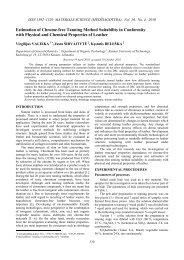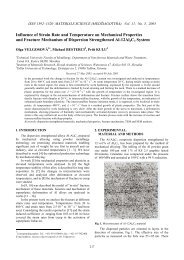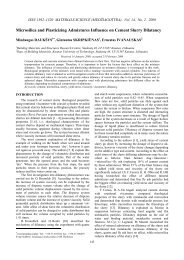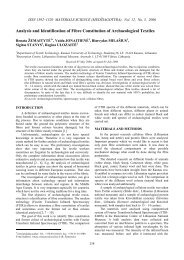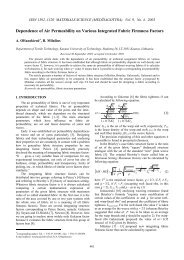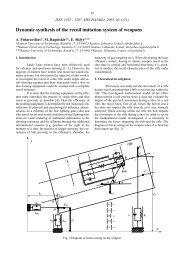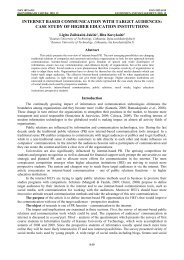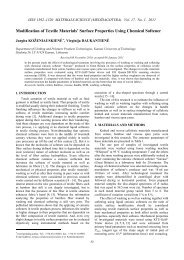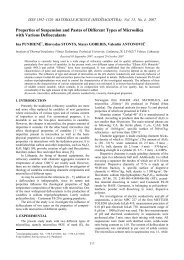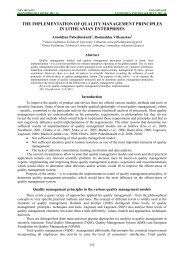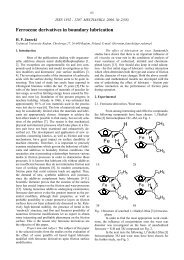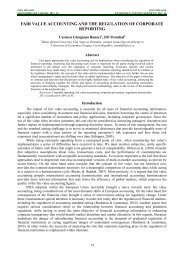Hydrophobic Antireflective Silica Coatings via Sol-gel Process - KTU
Hydrophobic Antireflective Silica Coatings via Sol-gel Process - KTU
Hydrophobic Antireflective Silica Coatings via Sol-gel Process - KTU
Create successful ePaper yourself
Turn your PDF publications into a flip-book with our unique Google optimized e-Paper software.
ISSN 1392–1320 MATERIALS SCIENCE (MEDŽIAGOTYRA). Vol. 14, No. 4. 2008<br />
<strong>Hydrophobic</strong> <strong>Antireflective</strong> <strong>Silica</strong> <strong>Coatings</strong> <strong>via</strong> <strong>Sol</strong>-<strong>gel</strong> <strong>Process</strong><br />
Jurgis PHILIPAVIČIUS 1 , Ivan KAZADOJEV 1 , Aldona BEGANSKIENĖ 1∗ ,<br />
Andrius MELNINKAITIS 2 , Valdas SIRUTKAITIS 2 , Aivaras KAREIVA 1<br />
1 Department of General and Inorganic Chemistry, Vilnius University, Naugarduko 24, LT-03225 Vilnius, Lithuania<br />
2 Laser Research Center, Vilnius University, Saulėtekio al. 10, LT-10222 Vilnius, Lithuania<br />
Received 01 June 2008; accepted 08 September 2008<br />
The optical properties and structure of hydrophobic antireflective coatings (AR) deposited from silica sol and HMDS<br />
and MTMS were characterized in detail in this study. The influence of sol modification parameters on the antireflective<br />
behaviour of coatings has been investigated. For the characterization of hydrophobic coatings the water contact angle<br />
measurements, UV-visible spectroscopy and atomic force microscopy were used. HMDS modified silica coating show<br />
the highest contact angle (165°) due to its better hydrophobic covering. It was determined that the hydrophobic HMDS<br />
modified coatings reduced reflectance as well as unmodified silica AR coatings. The Nd:YAG laser damage threshold of<br />
AR modified silica coating exceeded 35 J/cm 2 at 1064 nm.<br />
Keywords: hydrophobic, antireflection coatings, colloidal silica nanoparticles, sol-<strong>gel</strong> synthesis, laser damage threshold.<br />
1. INTRODUCTION ∗<br />
The reflection loss of an optical surface is related to<br />
the difference between the refractive indices of environment<br />
and the optical material. Due to their ability to<br />
decrease the reflectance and increase the transmittance of<br />
light and remove ghost images, antireflective (AR) coatings<br />
have recently attracted much interest for their applications<br />
in displaying devices and optical lenses systems<br />
[1 – 3]. The refractive index (nc) for an ideal homogeneous<br />
AR coating meets the condition of nc = (na ns) 1/2 , reflection<br />
will be decreased at the wavelengths near the quarterwavelength<br />
optical thickness, where na and ns are the<br />
refractive indices of the air and the substrate, respectively.<br />
For a glass substrate (ns ~1.5), the refractive index of AR<br />
material should be ~1.22. However, nature materials with<br />
such low refractive index are either rare. An effective<br />
method to obtain coatings with reduced refractive index is<br />
to introduce nanopores during the coating fabrication. The<br />
refractive index of porous coatings can be well tailored by<br />
controlling the percentage of pores introduced, in which<br />
larger percentage of pores leads to lower refractive index<br />
[4 – 7]. The most popular methods of preparation porous<br />
films are chemical vapour deposition, chemical etching<br />
and sol-<strong>gel</strong> processes [2, 8, 9].<br />
The silica nanoparticles (20 nm – 40 nm) made by the<br />
Stober sol-<strong>gel</strong> process is convenient for use as<br />
antireflective (AR) coatings for optics in high power laser<br />
system [10 – 14]. The AR coatings of porous silica are very<br />
attractive, due to low refractive indexes, low scatter and<br />
high laser damage thresholds. However, such AR coatings<br />
have one weakness – the water condensation on the surface<br />
of hydrophilic silica coating, what very important for the<br />
moisture sensitive optic elements or crystals as potassium<br />
dihydrogen phosphate. Because of absorption of water<br />
apour into the hydrophilic pores of normal porous silica<br />
AR film can increase nc and then lowers the antireflection,<br />
and it is necessary to make the AR films that<br />
∗ Corresponding author. Tel.: + 370-5-219-3109, fax.: +370-5-233-0987.<br />
E-mail address: aldona.beganskiene@chf.vu.lt (A. Beganskienė)<br />
283<br />
possess hydrophobicity. Therefore, the fabrication of AR<br />
coatings with water-repellent properties is quite important.<br />
The wettability of liquid to solid surface is governed<br />
by the chemical properties of solid surface and its surface<br />
morphology. So, commonly the acquirement of hydrophobic<br />
surface is out of two approaches chemical modification<br />
to surface or roughening the surface. Chemical modification<br />
is the way to achieve substitution of the hydrogen of<br />
hydroxyl group by attaching some alkyl or fluoralkyl<br />
groups. The modification of silica sol has been performed<br />
using hexamethyldisilazane (HMDS), trimethylalkokxysilane<br />
and dimethylalkokxysilane [15 – 17]. The methyl or<br />
trimethylsilyl (TMS) functionalization of silica colloids<br />
greatly modified the water adsorption isotherms, making<br />
them significantly more resistant to water absorption.<br />
In this study, we demonstrate the preparation of<br />
hydrophobic sol-<strong>gel</strong> AR coatings on glass substrates by<br />
spin-coating technique showing the dependence of variation<br />
of the AR behaviour on chemical modification<br />
parameters. The surface of silica nanoparticles was<br />
modified by adding different ration of reagents<br />
hexamethyldisilazane (HMDS) or methyltrimethoxysilane<br />
(MTMS) to colloidal silica sol.<br />
2. EXPERIMENTAL<br />
The particle size was determined from the micrographs<br />
obtained from TEM measurements. Transmission electron<br />
microscopy was performed on the PEM-100 electron<br />
microscope. A copper grid with a holey carbon film was<br />
dipped in the sol, dried at room temperature and analyzed<br />
in TEM. The results summarized from over hundred particles<br />
were used for the calculation of the average particle<br />
size and standard de<strong>via</strong>tions of each sample. The coating<br />
transmittance and reflectance of normally incident light<br />
was measured using a UV-vis spectrophotometers Perkin-<br />
Elmer Spectrum Lamda 19 and LOMO over the spectral<br />
range of 350 nm – 900 nm. The angle of incidence was<br />
fixed at 70° (from the normal), and the spectral range<br />
probed was 350 nm – 850 nm. The AFM images of the
silica coatings on glass were performed on Multimode<br />
Scanning Probe Microscope (Digital Instruments). For the<br />
characterization of surface properties, the measurements of<br />
water contact angle on KVS Instrument CAM 100 were<br />
recorded. The viscosity measurement was made using a<br />
viscometer (Anton Paar) at a shear rate of 200 s –1 and constant<br />
25 °C temperature. The laser damage tests were<br />
carried out according (ISO 11254-2 standard) by Nd:YAG<br />
lasers (the output laser pulse duration is 3.41 ns at<br />
1064 nm, frequency 10 Hz) using a spot size of approximately<br />
586 μm diameter. The laser damage threshold, i. e.<br />
the lowest intensity to cause on irreversible change, of the<br />
coatings was evaluated using a high power laser system.<br />
Light scattering losses were measured on apparatus for<br />
total scattering measurements at Laser Research Center of<br />
Vilnius University.<br />
Spin-coating methods on glass (lime, Bk-7) for producing<br />
AR coatings were used. In our investigations, for<br />
the preparation of thin colloidal silica films SCS P 6708<br />
(Specialty Coating Systems) was used. The coatings were<br />
used to deposit spinning-coating on well cleaned optical<br />
glass substrates at 2500 rpm – 3000 rpm. The coatings were<br />
dried at room temperature. <strong>Sol</strong>-<strong>gel</strong> synthesis of colloidal<br />
SiO2 nanoparticles was performed in non-aqueous system<br />
of TEOS. The precursor of SiO2 colloidal sol was prepared<br />
by the base catalyzed hydrolysis of tetraethylorthosilicate<br />
(Fluka, 99 %) by the following method of preparation of<br />
Stöber silica. The required amount of ammonium hydroxide<br />
(33 %, Riedel-de Haen) was added to half of the<br />
required volume of anhydrous ethanol. The alkaline<br />
solution was added to the solution of TEOS in ethanol with<br />
continuous stirring at 25 °C temperature. The obtained<br />
reaction mixture was stored for 14 days at room temperature<br />
to allow hydrolysis as much as possible. The final<br />
product consisted of colloidal suspension of 3 % SiO2<br />
nanoparticles in an anhydrous solvent. Methyl-modified<br />
SiO2 sols were prepared by adding different amount: 0.05,<br />
0.1, 0.25, 0.5, 1.0 p.p.vol. of hexamethyldisilazane<br />
(HMDS) or methytrimethoxysilane (MTMS) to the 3 %<br />
colloidal silica suspension. The modified sols were aged<br />
7 days at 25 °C temperature and for variation contact angle<br />
with aging time sample of HMDS (0.25 p.p.vol.) sol was<br />
aged from 1 to 50 days.<br />
3. RESULTS<br />
The monodispersed silica colloidal suspension that<br />
was mostly synthesized from modified Stöber method [10]<br />
was used to prepare single-layer porous AR films. The<br />
colloidal silica particles formed <strong>via</strong> the base-catalyzed<br />
hydrolysis and condensation of tetraethylorthosilicate<br />
(TEOS) in a non-aqueous mixture containing ethanol and<br />
ammonia were found to be colloidaly stable, having a narrow<br />
size (25 nm – 35 nm) distribution. After, the surface of<br />
silica nanoparticles was modified by adding different ratio<br />
of modification reagents hexamethyldisilazane (HMDS) or<br />
methytrimethoxysilane (MTMS) to colloidal silica sol. The<br />
colloidal silica particles were covered by hydroxyl groups,<br />
after HMDS or MTMS addition, some of the hydroxyl<br />
groups were replaced by methyl groups.<br />
284<br />
The TEM images of particles obtained from reaction<br />
mixtures 3 % SiO2 sol and modified with HMDS and<br />
MTMS are shown in Fig. 1.<br />
a b<br />
Fig. 1. TEM images of particles obtained from reaction mixtures<br />
3 % SiO2 sol and: a – HMDS (0.25), b – MTMS (0.25)<br />
TEM images showed that particles modified with<br />
MTMS were connected into large and irregular clusters.<br />
After mixing the unmodified silica sol and MTMS, the<br />
mono-dispersed particles linked and hydrophobic methyl<br />
group were introduced into clusters. The HMDS modified<br />
particles were spherical, besides in better dispersion than<br />
modified with MTMS. The methyl group could easily<br />
replace the Si-OH group on SiO2 particles surface. So, the<br />
surface morphology of HMDS modified was composed of<br />
spherical small particles (25 nm – 35 nm).<br />
Viscosity measurements are also of fundamental<br />
interest because they can furnish quantitative information<br />
concerning the structure of the colloid suspension and<br />
hence the specific interactions among particles. Fig. 2<br />
shows the change in viscosity with time for two modifiers<br />
HMDS and MTMS addition. As seen, the viscosity<br />
increased with increasing aging time, while the changes of<br />
viscosity of HMDS modified sol was small.<br />
Fig. 2. Variation of viscosity with time of modified sol with<br />
MTMS (0.25) and HMDS (0.25) sol<br />
Atomic force microscope (AFM) was used for the<br />
characterization of surface morphology of silica coatings.<br />
AFM images exhibited a direct relation between the<br />
surface and morphology with nature and concentration of<br />
modified reagents. The AFM images of unmodified and<br />
modified with MTMS and HMDS coatings with 1.5 and<br />
0.1 ratio are shown in Figs. 3 and 4.
a b<br />
Fig. 3. AFM images of surface morphology of coatings obtained<br />
from sol: a – unmodified silica sol, b – MTMS (0.25)<br />
modified<br />
a b<br />
Fig. 4. AFM images of surface morphology of coatings obtained<br />
from sol: a – modified HMDS (0.25), b – HMDS (0.1)<br />
The surface morphology of the coatings has a large<br />
effect on water on water repellence as well on light scattering<br />
on surface. The MTMS modified coating have a<br />
smooth and continuous surface (roughness Rq 1.8 nm),<br />
rather than typical particle-bump morphology of unmodified<br />
silica coating (Rq 3.2 nm). The average surface<br />
roughness Rq of HMDS modified film increases with the<br />
modifier content. The coating obtained from sol with<br />
highest HMDS (1.5 p.p.v.) content have the biggest<br />
Rq – 3.5 nm, while with 0.1 p.v. of HMDS Rq – 2.8 nm.<br />
From the AFM image we can conclude that just obtained<br />
HMDS modified coating is composed of ≈40 nm silica<br />
particles. This kind of morphology on coatings modified<br />
with HMDS generally meant lots of mesopores in film,<br />
which ensured the low refractive index nc needed for<br />
antireflective behaviour of coatings. But, that roughness is<br />
small enough not to impact intence surface light scattering,<br />
which reduces antireflection.<br />
The hydrophobicity of coating was shown by the<br />
water/coating contact angle as a function of the ration<br />
modification reagents and aging time of modified MTMS<br />
and HMDS sols (Fig. 5 and Fig. 6). The hydrophobicity<br />
was not the same for the coating from different methylmodified<br />
silica sols.<br />
a b<br />
Fig. 5. Images of water drops on coatings surfaces: a – colloidal<br />
SiO 2 (21°), b – HMDS modified (165°)<br />
For the MTMS modified coating, the water contact<br />
angle increased from 32° to 71° after 14 days aging of sol.<br />
285<br />
And, for the HMDS modified coating/water contact angle<br />
has reached 140° after 14 days. The maximal value 165° of<br />
the coating prepared from modified with HMDS after 40 d.<br />
aging, while after 50 aging day small decreasing of hydrophobicity<br />
was observed (Fig. 7).<br />
Fig. 6. Contact angles with modifier concentration for coatings<br />
after 14 day aging<br />
Fig. 7. Variation water contact angles with aging time for HMDS<br />
(0.25) modified silica coatings<br />
The antireflection of modified one-side coatings is<br />
represented by the transmittance shown in Figs. 8 and 9. It<br />
is evident that in both cases of modification with HMDS<br />
and MTMS the obtained modified coatings visibly reduced<br />
the reflectance of the glass substrate as compared to the<br />
unmodified colloidal SiO2 coating.<br />
Transmittance (%)<br />
95<br />
94<br />
93<br />
92<br />
91<br />
SiO 2<br />
glass<br />
HMDS modified<br />
90<br />
300 400 500 600 700 800 900<br />
Wavelength (nm)<br />
MTMS modified<br />
Fig. 8. Transmission spectra for BK-7 glass and coating obtained<br />
from sol: a – 3 % SiO2, b – modified 0.25 HMDS,<br />
c – 0.25 MTMS
As seen (Fig. 8), the transmission spectra show a sinusoidal<br />
shape with a single maximum if the quarter-wave<br />
thickness occurred over the range of 400 nm – 800 nm.<br />
Such behaviour is typical and expected for the single layer<br />
coatings. The determined maximum of transmission for<br />
one side coated film obtained from HMDS modified sol on<br />
glass was 94.2 % (400 nm – 550 nm), while for uncoated<br />
glass was 91.3 %. The highest transmittance (93.7 %) for<br />
MTMS modified coating was achieved at 410 nm.<br />
The best AR behaviour showed the coatings obtained<br />
from HMDS: silica sol (0.25 : 1) (Fig. 9). The highest<br />
absolute transmittance (95.0 %) was achieved at 527 nm.<br />
The transmittance of modified coating decreases to with<br />
decreasing HMDS amount.<br />
Transmitance (%)<br />
96<br />
94<br />
92<br />
90<br />
88<br />
86<br />
84<br />
glass<br />
0.25<br />
0.1<br />
0.05<br />
400 600 800<br />
Wavelenght (nm)<br />
Fig. 9. Transmission spectra for coating on lime glass obtained<br />
from modified silica sol with different concentration<br />
HMDS<br />
The surface topology of the substrate and the coating<br />
determine the quality of the coating in terms of their<br />
optical transmission. The surface morphology of the<br />
coatings can lead to surface scattering and can reduce the<br />
transmitted. The map of light scattering loses for modified<br />
coating is presented in Fig. 10.<br />
Fig. 10. Light scattering losses map of HMDS modified silica<br />
coating on BK-7 glass<br />
286<br />
The bigger light scattering losses around the sample<br />
sides were obtained. The HMDS modified coating has total<br />
0.02 % scattering losses.<br />
The laser-induced damage threshold (LIDT) is very<br />
important parameter of antireflective coatings. To compare<br />
with the coating obtained from unmodified sol and HMDS<br />
modified sol were tested under the same conditions. The<br />
laser damage tests were carried out on a Nd: YAG lasers at<br />
1064 nm (1 H) (single-shot 3.4 ns, pulse repetition rate<br />
10 Hz). The laser damage threshold AR unmodified silica<br />
coating exceeded 15.22 J/cm 2 at 1064 nm and 21.82 J/cm 2<br />
at 355 nm [18], while modified HMDS – 35 J/cm 2 at<br />
1064 nm.<br />
4. CONCLUSIONS<br />
The optical properties and structure of hydrophobic<br />
antireflective coatings (AR) deposited from silica sol and<br />
HMDS or MTMS as modifiers were characterized in detail.<br />
The contact angle of water increased with increasing<br />
amount of HMDS or MTMS, but HMDS modified coating<br />
had much higher contact angle. It was determined that the<br />
hydrophobic HMDS modified coatings reduced reflectance<br />
as well as unmodified silica AR coatings. The HMDS<br />
modified sample has total 0.02 % scattering losses. The<br />
laser damage threshold modified silica coating exceeded<br />
35 J/cm 2 at 1064 nm The obtained hydrophobic antireflective<br />
coatings <strong>via</strong> sol-<strong>gel</strong> method could be used for the<br />
coating optical elements sensitive to humidity.<br />
Acknowledgments<br />
The financial support from the Lithuanian State<br />
Science and Studies Foundation under project LADA<br />
(No. B-07030) is gratefully acknowledged.<br />
REFERENCES<br />
1. Chen, D. Antireflection (AR) <strong>Coatings</strong> Made by <strong>Sol</strong>-Gel<br />
<strong>Process</strong>: A Review <strong>Sol</strong>ar Energy Materials & <strong>Sol</strong>ar Cell<br />
68 2003: pp. 313 – 336.<br />
2. Nostell, P., Roos, A., Karlson, B. Optical and Mechanical<br />
Properties of <strong>Sol</strong>-Gel <strong>Antireflective</strong> Films for <strong>Sol</strong>ar Energy<br />
Applications Thin <strong>Sol</strong>id Film 434 1999: pp. 170 – 175.<br />
3. Nostell, P., Roos, A., Karlson, B. Antireflection of<br />
Glazings for <strong>Sol</strong>ar Energy Applications <strong>Sol</strong>ar Energy<br />
Materials and <strong>Sol</strong>ar Cell 54 1998: pp. 223 – 233.<br />
4. Gombert, A., Glaubitt, W., Rose, K., Dreibholz, J.,<br />
5.<br />
Blasi, B., Heinzel, A., Sporn, D., Doll, W., Wittwer, V.<br />
Subwavellenght-Structured <strong>Antireflective</strong> Surface on Glass<br />
Thin <strong>Sol</strong>id Films 351 1999: pp. 73 – 78.<br />
Hammarberg, E., Roos, A. Antireflection Treatment of<br />
Low Emitting Glazings for Energy Efficient Windows with<br />
High Visible Transmittance Thin <strong>Sol</strong>id Films 442 2003:<br />
pp. 222 – 226.<br />
6. Thomas, I. Method for the Preparation of Porous <strong>Silica</strong><br />
Antireflection <strong>Coatings</strong> Varying in Refractive Index from<br />
1.22 to 1.44 Applied Optics 31 1992: pp. 6145 – 6149.<br />
7. Thomas, I. High Laser Damage Threshold Porous <strong>Silica</strong><br />
<strong>Antireflective</strong> <strong>Coatings</strong> Applied Optics 25 1986:<br />
pp. 1481 – 1483.<br />
8. Biswas, P.K., Sujatha Devi, P. Porous Anti-reflective<br />
<strong>Coatings</strong> with a High Spectral Coverage by <strong>Sol</strong>-Gel Spin<br />
Coating Technique Journal of Material Science Letters 22<br />
1999: pp. 181 – 183.
9. Hench, L. L, West, J. K. The <strong>Sol</strong>-Gel <strong>Process</strong> Chemical<br />
Review 90 1990: pp. 33 – 72.<br />
10. Stober, W. Fink, A., Bohn, E. Controlled Growth of<br />
Monodisperse <strong>Silica</strong> Spheres in the Micron Size Range<br />
15. Suratwala, I., Hanna, L., Miller, E. L., Whitman, P. K,<br />
Thomas, I. M., Ehrmann, P. R. Surface Chemistry and<br />
Trimethylsilyl Functionalization of Stober <strong>Silica</strong> <strong>Sol</strong>s<br />
Journal of Non-Crystaline <strong>Sol</strong>ids 316 2003: pp. 349 – 363.<br />
Journal Interface Science 26 1968: pp. 62 – 69. 16. Xu, Y., Zhang, B., Fan, W. H., Sun, H. Y. <strong>Antireflective</strong><br />
11. Okudera, H., Hozumi, A. The Formation and Growth<br />
Mechanisms of <strong>Silica</strong> Thin Film and Spherical Particles<br />
through the Stober <strong>Process</strong> Thin <strong>Sol</strong>id Films 434 2003:<br />
pp. 62 – 68.<br />
12. Green, D. L., Lin, J. S., Lam, Y., Hu, M. Z.,<br />
Schaefer, D. W., Harris, M. T. Size, Volume Fraction, and<br />
Nucleation of Stober <strong>Silica</strong> Nanoparticles Journal of<br />
Colloid and Interface Science 266 2003: pp. 346 – 358.<br />
13. Bogush, G. H., Zukovski, C. F. Studies of the Kinetics of<br />
Precipitation of Uniform <strong>Silica</strong> Patrticles throught the<br />
Hydrolysis and Condensation of Silicon Alkokside Journal<br />
of Colloidal and Interface Science 142 1991: pp. 1 – 18.<br />
14. Xu, Y., Zhang, B., Fan, W. H., Sun, H. Y. <strong>Sol</strong>-Gel<br />
Broadband <strong>Antireflective</strong> Single-Layer <strong>Silica</strong> Films with<br />
High Laser Damage Threshold Thin <strong>Sol</strong>id Films 440<br />
2003: pp. 180 – 183.<br />
287<br />
<strong>Silica</strong> Thin Films with Super Water Repellence <strong>via</strong> <strong>Sol</strong>-Gel<br />
Applied Optics 42 2003: pp. 108 – 112.<br />
17. Xu, Y., Zhang, B., Fan, W. H., Sun, H. Y. Comparative<br />
Study on <strong>Hydrophobic</strong> <strong>Antireflective</strong> Films from the Three<br />
Kinds of Methyl-Modified <strong>Silica</strong> <strong>Sol</strong>s Journal of Non-<br />
Crystaline <strong>Sol</strong>ids 351 2005: pp. 258 – 266.<br />
18. Beganskiene, A., Melninkaitis, A., Sakirzanovas, S.,<br />
Kazadojev, I., Sirutkaitis, V. Kareiva, A. <strong>Sol</strong>-Gel Derived<br />
<strong>Antireflective</strong> Coating with Controlled Thickness and<br />
Reflective Index Journal Material Science Poland 25<br />
2007: pp. 817 – 824.<br />
Presented at the 17th International Conference<br />
"Materials Engineering’2008"<br />
(Kaunas, Lithuania, November 06 – 07, 2008)



